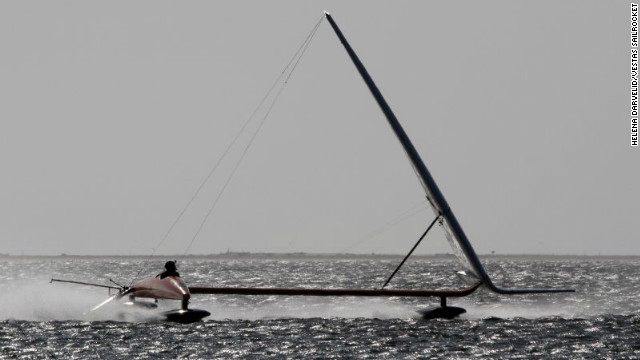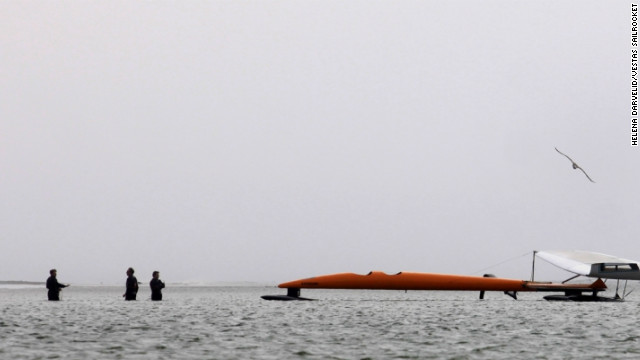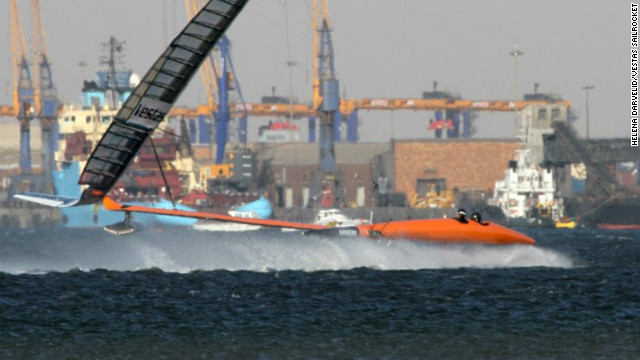The sail boat that thinks it's a plane
STORY HIGHLIGHTS
- Team behind Vestas Sailrocket 2 aims to break world speed sailing record
- Creators say vessel behaves like a boat below water and a plane above it
- Record is held by U.S. kite surfer who reached 55.65 knots over 500 meters
"Everything above the water is an aeroplane and everything below the water behaves just like a boat," says Larsen, a professional sailor who's now turned his attention to breaking the speed sailing record, describing it as his lifetime mission.
To attempt the feat, Larsen and his small team of naval architects, engineers and yachtsmen and women, created the sailrocket -- a hybrid boat/plane. "A large part of this boat is flying, it's supported by aerodynamics," says Larsen . "When it's going at high speed, it's like a well-built paper airplane."
The record is open to any craft, as long as it's using wind and water, and there is at least one person on board. Currently it is held by American kite surfer Rob Douglas, who reached 55.65 knots (103 kilometres per hour) over the required 500 meter course in 2010.
When it's going at high speed, it's like a well-built paper airplane.
Paul Larsen
Paul Larsen
Last month the team made another record attempt in southern Africa. Walvis Bay in Namibia provides the ideal wind conditions for the sailrocket. The group spent days trying to reach 60 knots -- the speed they believe will not only get them the record, but also keep it with them.
"The boat is based on this whole new idea," explains Larsen. "It's got no overturning forces." He says the wind and water forces are in alignment. "It's like someone trying to push you over by pushing at the soles of your feet."
The craft may be using the latest technology, but its concept is based on a craft that was written about nearly five decades ago. American rocket scientist Bernard Smith wrote about a sailboat in 1963 that he believed could reach 40 knots -- a concept that was well ahead of his time.
Larsen's team tracked down Smith in 2007 to tell the then 97-year-old that they had broken the 40 knots, using the ideas Smith came up with 44 years earlier. Building on that design, they have since been able to go 50 knots and are pushing to go even faster.
In Namibia last month they were unable to go any faster than 51 knots, but Larsen is certain they're not far off the mark. He thinks it's a matter of redesigning the boat's foils. "One of these days we'll get the foil right and I think we'll smash the record."
It is dangerous, you don't realize the consequences if the smallest thing goes wrong.
Paul Larsen
Paul Larsen
He's now back in England working on new foils that will hopefully provide them with the edge they need to get the record. They aim to return to Namibia, perhaps as early as April, to try again.
But the attempts are not without risks. Larsen likens the sailrocket's 500 meter course to an aircraft going down the runway, but with too much weight in its nose so it can't take off.
"It is dangerous," he concedes. "You go out there and you don't realize the consequences if the smallest thing goes wrong."
He says the worst crashes are the ones when the boat dives directly into the water. "That's a killer. At least in the air you slow down."
But despite the dangers, Larsen and his team won't stop until they hit the 60 knot mark and take with it the world speed sailing record.

 The team behind the Vestas Sailrocket 2 describe it as behaving like a boat below water and a plane above.
The team behind the Vestas Sailrocket 2 describe it as behaving like a boat below water and a plane above.  The team is aiming for the world speed sailing record, which is currently held by American kite surfer Rob Douglas, who has reached 55.65 knots over 500 meters.
The team is aiming for the world speed sailing record, which is currently held by American kite surfer Rob Douglas, who has reached 55.65 knots over 500 meters.  So far the Vestas Sailrocket 2 has reached the 51 knot mark, and its creators are confident it will get to 60 knots.
So far the Vestas Sailrocket 2 has reached the 51 knot mark, and its creators are confident it will get to 60 knots.  The Vestas Sailrocket 2 was lauched early last year after being constructed in England.
The Vestas Sailrocket 2 was lauched early last year after being constructed in England. 



ไม่มีความคิดเห็น:
แสดงความคิดเห็น